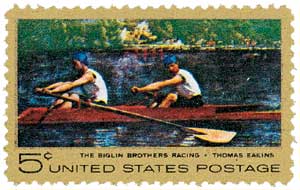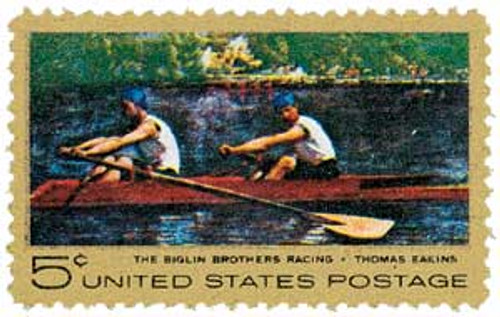
# AC725 FDC - Thomas Eakins The Biglin Brothers racing, 12/2/1967
Â
Own this Poster And Stamp Featuring Same National Gallery Of Art PaintingÂ
Artist Thomas Easkins' painting, The Biglin Brothers Racing, is featured on this poster and its stamp (US #1335). The poster measures 11" X 14" and is made of heavy card stock. The original painting hangs in the National Gallery of Art in Washington, DC. A First Day of Issue postmark ties the stamp to the poster.  American Painter Thomas Eakins portrayed scenes on canvas with photographic brilliance. Â
Â
Birth Of Thomas Eakins
As a child, Eakins watched his father, a writing master and calligraphy teacher, work. By the time he was 12, he was skilled in line drawing and had an excellent grasp of perspective. Eakins also enjoyed athletics such as rowing, ice-skating, swimming, wrestling, and gymnastics. He would later paint these activities and encourage his students to do them.
Â

After high school, Eakins attended the Pennsylvania Academy of the Fine Arts. He also studied at Jefferson Medical College and considered becoming a surgeon, but was more strongly drawn to art. Eakins then spent four years in Europe. While there, he studied at the École des Beaux-Arts and was just the second American painter to study under Jean-Léon Gérôme. Taking little interest in the Impressionist movement spreading in Europe, Eakins was drawn to realism.
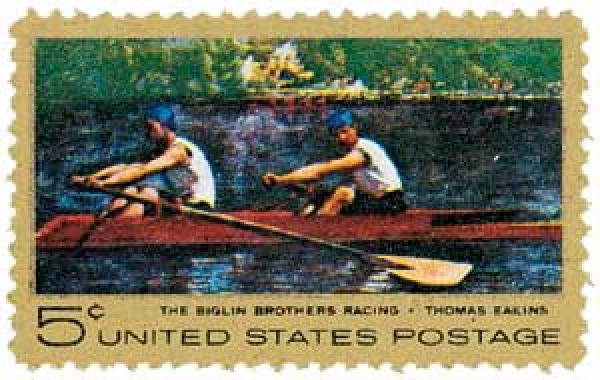
Upon returning to America, Eakins’ first works were a series of rowing scenes. They proved popular and he sold his first painting, The Sculler, in 1874. Eakins enjoyed painting outdoor scenes of this and other sports, but also explored Victorian interiors with his family and friends as the subjects. Eakins was especially interested in the human form, and many of his works included nudes. Â
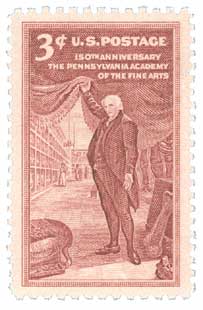
In 1876, Eakins returned to the Pennsylvania Academy of the Fine Arts to teach as a volunteer. He began receiving a salary two years later and was made director in 1882. Eakins’ instruction methods were controversial. He didn’t have his students study old still lifes. He gave them a brief introduction to drawing in charcoal so he could quickly move them to painting, so that they could work in color as soon as possible. Eakins also encouraged students to use photographs as source work to better study their subjects and motion. Â
Under Eakins’ leadership, the school’s art program was one of the most “liberal and advanced in the world.â€Â However, it wasn’t without its controversy. For some time, some of the younger professors had wanted to remove him and assume control of the school themselves. This created a rift between Eakins and the board of directors. After he removed the loincloth of a male model in a class of female students, he was forced to resign in 1886. Some of the students, however, sided with Eakins and formed their own school, the Art Students’ League of Philadelphia. Eakins went on to teach at other schools including the Art Students League of New York, the National Academy of Design, the Cooper Union, and the Art Students’ Guild.
During his earlier studies in Europe, Eakins had witnessed how the French realists used photography in their painting studies. At the time in America, it was looked down on as a shortcut. But Eakins was fascinated by it and conducted a number of motion studies, including some with famed photographer Eadweard Muybridge. While Muybridge would capture multiple separate images to be displayed on his movie projector, Eakins captured precise movements in the same negative. He would use these as the basis for his paintings, enabling them to be very lifelike.
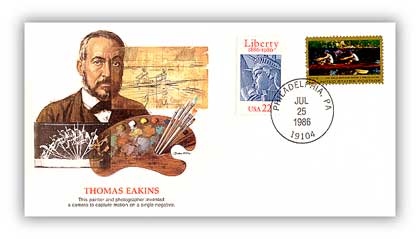
During his lifetime, Eakins produced some 250 portraits. However, he didn’t like to do static paintings of people sitting still. He liked to paint people in motion and at work. One of his most famous works in this category is The Gross Clinic, which pictures Dr. Samuel D. Gross watching over an operation. While Eakins was recognized for his realistic painting, some were turned off by the subject matter. Eakins painted portraits of hundreds of Philadelphia residents from all walks of life, both indoors and out, creating an extensive record of life in the city during the late 19th and early 20th centuries.
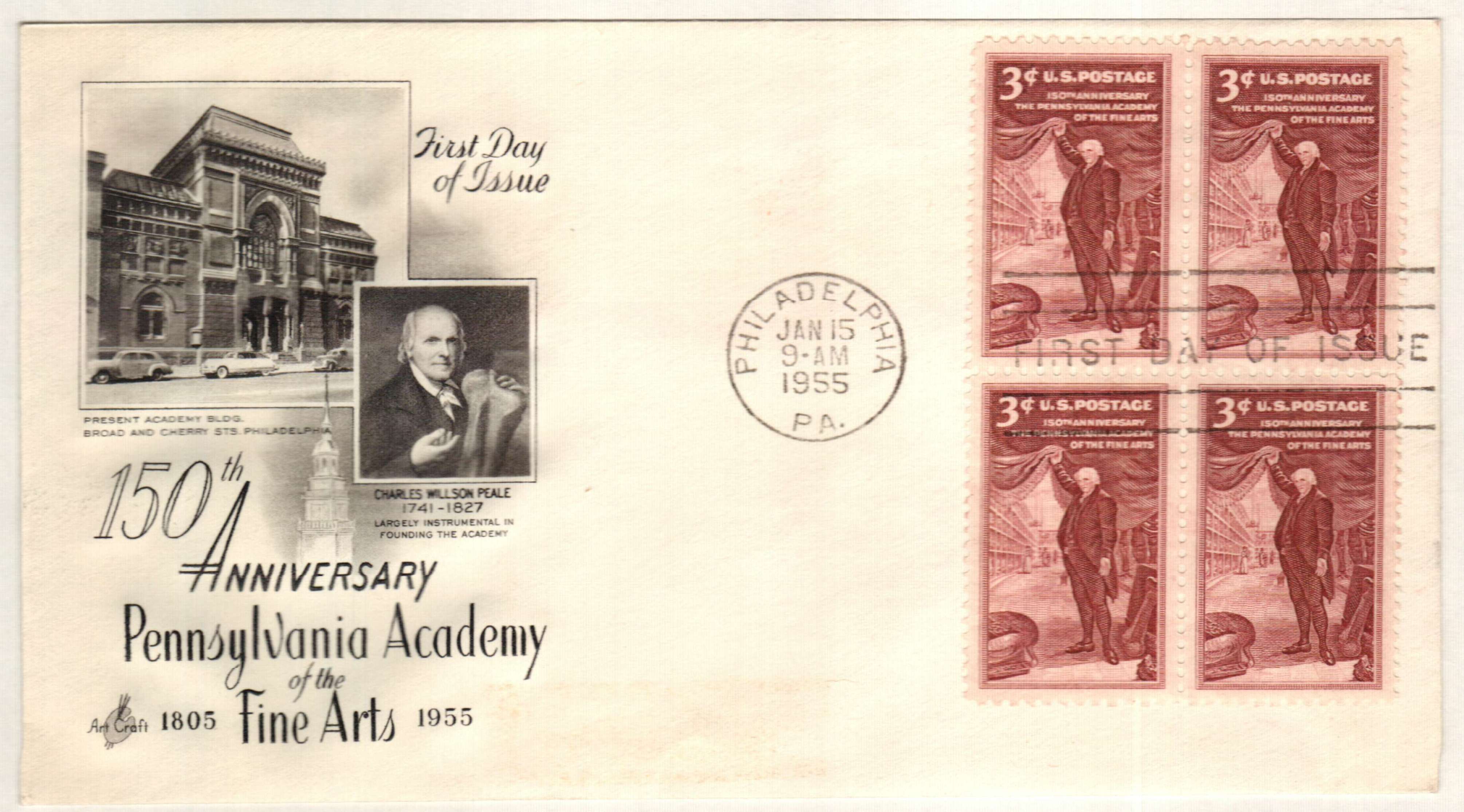
Eakins died on June 25, 1916, in Philadelphia. During his lifetime, he received few honors or recognition for his work. Since his death though, he’s been regarded as one of the most important artists in American history. One art historian said he was “the strongest, most profound realist†of his lifetime.  Â
Â
Own this Poster And Stamp Featuring Same National Gallery Of Art PaintingÂ
Artist Thomas Easkins' painting, The Biglin Brothers Racing, is featured on this poster and its stamp (US #1335). The poster measures 11" X 14" and is made of heavy card stock. The original painting hangs in the National Gallery of Art in Washington, DC. A First Day of Issue postmark ties the stamp to the poster.  American Painter Thomas Eakins portrayed scenes on canvas with photographic brilliance. Â
Â
Birth Of Thomas Eakins
As a child, Eakins watched his father, a writing master and calligraphy teacher, work. By the time he was 12, he was skilled in line drawing and had an excellent grasp of perspective. Eakins also enjoyed athletics such as rowing, ice-skating, swimming, wrestling, and gymnastics. He would later paint these activities and encourage his students to do them.
Â

After high school, Eakins attended the Pennsylvania Academy of the Fine Arts. He also studied at Jefferson Medical College and considered becoming a surgeon, but was more strongly drawn to art. Eakins then spent four years in Europe. While there, he studied at the École des Beaux-Arts and was just the second American painter to study under Jean-Léon Gérôme. Taking little interest in the Impressionist movement spreading in Europe, Eakins was drawn to realism.

Upon returning to America, Eakins’ first works were a series of rowing scenes. They proved popular and he sold his first painting, The Sculler, in 1874. Eakins enjoyed painting outdoor scenes of this and other sports, but also explored Victorian interiors with his family and friends as the subjects. Eakins was especially interested in the human form, and many of his works included nudes. Â

In 1876, Eakins returned to the Pennsylvania Academy of the Fine Arts to teach as a volunteer. He began receiving a salary two years later and was made director in 1882. Eakins’ instruction methods were controversial. He didn’t have his students study old still lifes. He gave them a brief introduction to drawing in charcoal so he could quickly move them to painting, so that they could work in color as soon as possible. Eakins also encouraged students to use photographs as source work to better study their subjects and motion. Â
Under Eakins’ leadership, the school’s art program was one of the most “liberal and advanced in the world.â€Â However, it wasn’t without its controversy. For some time, some of the younger professors had wanted to remove him and assume control of the school themselves. This created a rift between Eakins and the board of directors. After he removed the loincloth of a male model in a class of female students, he was forced to resign in 1886. Some of the students, however, sided with Eakins and formed their own school, the Art Students’ League of Philadelphia. Eakins went on to teach at other schools including the Art Students League of New York, the National Academy of Design, the Cooper Union, and the Art Students’ Guild.
During his earlier studies in Europe, Eakins had witnessed how the French realists used photography in their painting studies. At the time in America, it was looked down on as a shortcut. But Eakins was fascinated by it and conducted a number of motion studies, including some with famed photographer Eadweard Muybridge. While Muybridge would capture multiple separate images to be displayed on his movie projector, Eakins captured precise movements in the same negative. He would use these as the basis for his paintings, enabling them to be very lifelike.

During his lifetime, Eakins produced some 250 portraits. However, he didn’t like to do static paintings of people sitting still. He liked to paint people in motion and at work. One of his most famous works in this category is The Gross Clinic, which pictures Dr. Samuel D. Gross watching over an operation. While Eakins was recognized for his realistic painting, some were turned off by the subject matter. Eakins painted portraits of hundreds of Philadelphia residents from all walks of life, both indoors and out, creating an extensive record of life in the city during the late 19th and early 20th centuries.

Eakins died on June 25, 1916, in Philadelphia. During his lifetime, he received few honors or recognition for his work. Since his death though, he’s been regarded as one of the most important artists in American history. One art historian said he was “the strongest, most profound realist†of his lifetime.  Â




